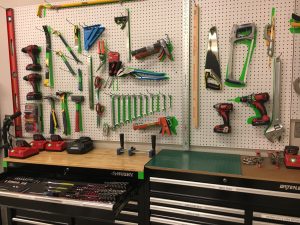The first thing you see when you enter the Boral Discovery Center in San Antonio, Texas, is what you can’t see—no clutter, no chaos, no extraneous noise. Because while nearly 30 people, including scientists, engineers, and support staff, work throughout the facility’s labs with numerous machines, hundreds of materials, and thousands of samples, a concentrated focus on safety and efficiency guides each step.
Assisting in those efforts is a facility-wide adherence to LEAN principles, much like you would find at some manufacturing plants.
“We are a lab with many, many projects and many samples,” notes Sarah Fortenberry, a Discovery Center research technician who also leads the facility’s LEAN programs. “So you have to manage not only the individual projects as well as the amount of materials coming in and going out. LEAN principles help us do that.”
Fortenberry notes that following LEAN guidelines also is key to maintaining a safe, healthy environment.
Here are a few of the LEAN tools the Discovery Center has implemented:
• Shadow Board: In areas with tools and equipment, storage areas are outlined and labeled, as shown in this photo. This includes everything from duct tape rolls to a hammer to extension cords. “There’s no wasted time trying to find an item,” Fortenberry notes. “It’s labeled, it’s where it should be.” • The 5 S’s:
• The 5 S’s:
Sort: Frequently determine what you actually use and get rid of the rest. This helps keep work areas clutter-free and safe.
Set in order: Label everything and where it goes. The most important items should be the closest.
Shine: Keep work areas clean.
Standardize: Have a standard method for tools and equipment. Everything is labeled—every tool, every shelf, every drawer. This also pertains to samples, which ensures every test is tracked and identifiable. The process of managing samples is the primary reason that LEAN is essential at the Discovery Center.
Sustain: Establish how you keep the workplace clean and a cleaning schedule.
• 3C Board: The three Cs stand for Concern, Cause, Countermeasure. In each work area, the team has a 3C board. If something is wrong in the area, it goes up on the board, what’s causing the problem, and, eventually, what is being done to fix the problem.
• Total Productive Maintenance: Broken machines lead to costly downtime, so each machine has a list of maintenance steps needed to keep it running properly.
• 5S Fridays: At the end of every Friday, the team convenes to address problems on 3C boards. “We work as a team to get to and maintain a sustaining level of production,” Fortenberry notes.
• Kaizen: Kaizen is Japanese for “continual improvement.” The team hosts kaizen events in which they visit areas of the lab and track team members’ steps to see where there is wasted movement and how those steps can be consolidated. Bringing in team members who don’t work in that area provides a fresh perspective and out-of-the-box thinking.
“It’s made us more of a team, working as a group to improve our areas,” Fortenberry says. “Through the kaizen events and 5S Fridays, we can do something in a short period of time that would take someone weeks to do alone.”


